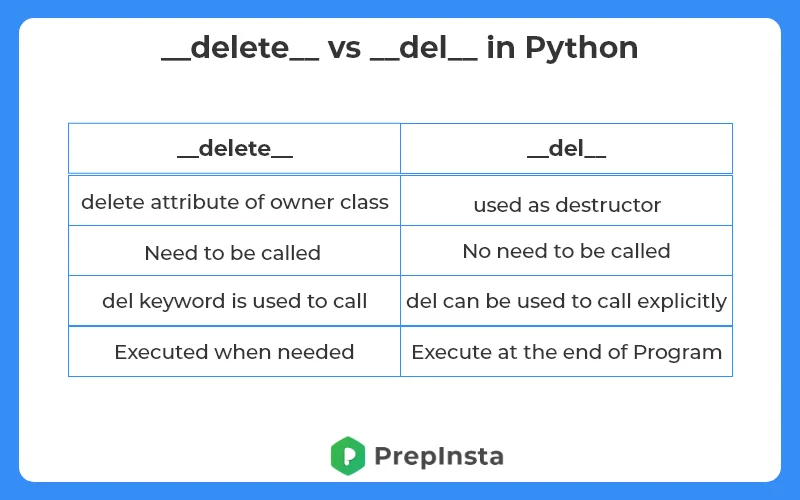__delete__ vs __del__ in Python
__delete__ vs __del__ in Python
Both __delete__ and __del__ are dunder or magic methods in Python. Dunder or magic methods in Python are the methods having two prefix and suffix underscores in the method name. Dunder here means “Double Under (Underscores)”. These are commonly used for operator overloading.

__del__
- The __del__ method is similar to destructor in c++ and Java.
- Destructors are used to destroying the object’s state.
Syntax:
class ClassName:
def __del__( self ,):
##body
Code #1:
#python Program
#Rishikesh
#destructor
#__del__
class A(object):
def __init__(self):
self.str1 = “PrepInsta”
print(“Object Created” , self.str1)
def __del__(self):
print(‘Del is called’)
ob = A()
Output:
Object Created PrepInsta
Del is called
Note: The destructor was called after the program ended or when all the references to the object are deleted
__delete__
- __delete__ is used to delete the attribute of an instance i.e Called to delete the attribute on an instance of the owner class.
Note: This method only deletes the attribute which is a descriptor.
Syntax
def __delete__(self, instance):
body of delete
object. __delete__(self, instance)
self
Required. An instance of the class, passed automatically on call.
Code #2
#python Program
#Rishikesh
#__delete__
# this is our descriptor object
class Bar(object):
def __init__(self):
self.value = ”
def __get__(self, instance, owner):
print (“returned from descriptor object”)
return self.value
def __set__(self, instance, value):
print (“set in descriptor object”)
self.value = value
def __delete__(self, instance):
print (“deleted in descriptor object”)
del self.value
class Foo(object):
bar = Bar()
f = Foo()
f.bar = 10
print (f.bar)
del f.bar
Output:
set in descriptor object
returned from descriptor object
10
deleted in descriptor object



Login/Signup to comment